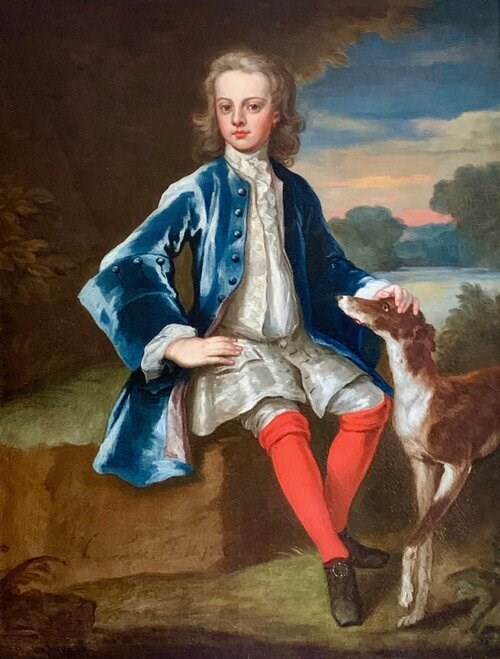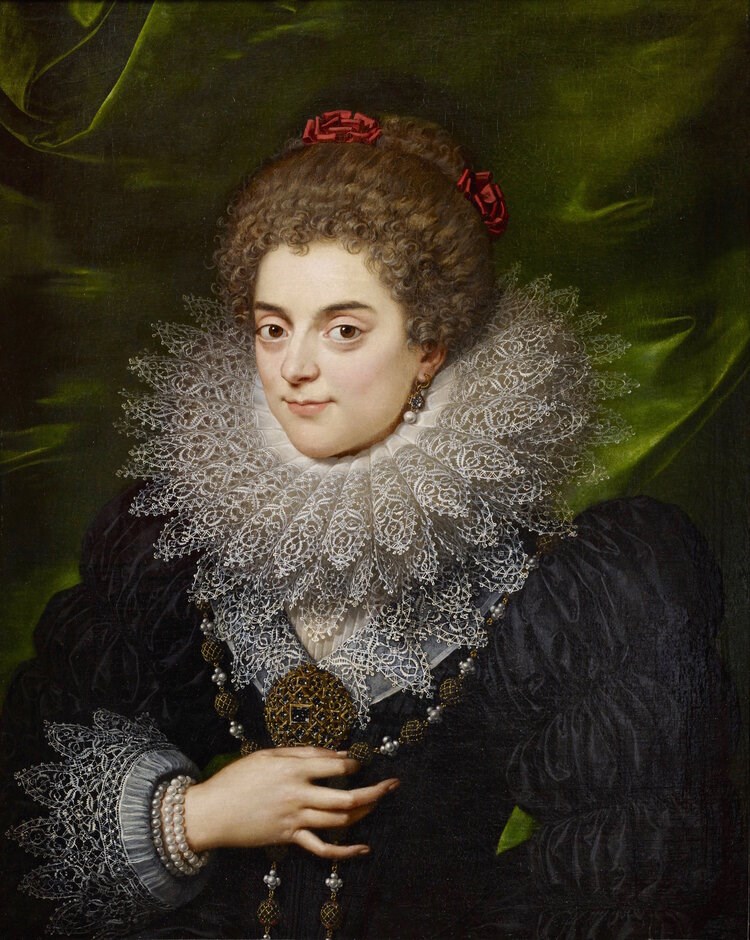Purchasing Portraits
03 June 2021
SharePortraits are having a moment - but why do people buy pictures of strangers?
Joe Lloyd
Joe Lloyd is a journalist who writes about architecture and visual art for The Culture Trip, Elephant, and The Economist's 1843 magazine, among others.

John Vanderbank (1694-1739), Portrait of a Young Gentleman and his Greyhound, signed by the artist ‘John Vanderbank 1726’, 127 x 102cm.
Image courtesy of Period Portraits.
Last month, a work by a little-known old master defied all expectations. German baroque painter Johann Heinrich Schönfeld’s A bearded man in armour was auctioned for $150,000 at Christie’s, almost double its $80,000 estimate. It is a striking painting, warm-toned and subtly articulated. But Schönfeld, for all his talent, is hardly the sort of name that usually sets the art market alight. What could have caused this uptick?
Portraits are enjoying a moment. The past few years have witnessed numerous acclaimed exhibitions dedicated specifically to the genre, from Goya at the National Gallery to Lucian Freud at the Royal Academy. But their popularity reaches beyond the hallowed halls of the art world. “You see portraits now on television adverts,” says art dealer Nick Cox, “you see them everywhere. Now even young couples putting their first home together might potentially buy a Victorian portrait to put in their dining room. It’s a trend across all eras and price points.”
Cox runs Period Portraits, a web-based dealership specialising in 17th to 20th century portraits. He believes recent years have seen a shift among collectors. “Though there are still people who are just into, for example, Civil War portraits or military uniform,” he explains, “the new type of collector often buys across a whole range of genres and periods.”

Frans Pourbus the Younger (1569 – 1622), An unknown noblewoman of the Bourbon court, oil on canvas, 75 x 58 cm, circa 1615.
Image courtesy of The Weiss Gallery, London.
Portraiture is itself an enormous field, and an immensely varied one. For many artists, it was a route to success. Portraits are generally smaller-scale and less time-intensive than history paintings. They also fed a near-constant demand. Rulers and courtiers needed them to project their might and majesty. The ever-growing middle classes followed, commissioning portraits as status symbols and decorations. Nicolaes Maes, among the most in-demand of Dutch Golden Age portraitists, left five houses and 11,000 guilders at his death (his tutor Rembrandt only earned around 340 guilders in a good year).
Formal painted portraiture began to wane in the 19th century as photography engulfed some of its functions, though numerous artists continued to paint portraits. But portraiture in its loosest sense is arguably more prominent than ever: in profile pictures, avatars, social media posts. “At the moment,” explains Cox, “we live in a selfie-obsessed society, full of disposable images. Portraits do a similar thing, but with more permanence.” Their current popularity combines our mania for depictions of people with a desire for less ephemeral, more material images.
While the prosperous and powerful used portraits to immortalise themselves and their families, however, today’s collectors seldom have such connections. To collect historic portraits is to be surrounded by long-dead strangers. Wherein lies the appeal? Sometimes, it comes down to the aesthetic. “As with any other work of art,” says Mark Weiss of Weiss Gallery, which has specialised in old master portraits since 1985, “there is the intrinsic beauty of the portrait itself. Portraits of a beautiful or handsome sitter will always have great decorative appeal.”
An image of an attractive person can light up a room. As can one of a strikingly unattractive person: cognitive scientists have found that beautiful and ugly artworks light up the same area of the brain. This might explain the enduring popularity of works like Quentin Matsys’ The Ugly Duchess, or the enormous $137.5 million auction price achieved by Willem de Kooning’s Woman III in 2006.
But there are reasons beyond the purely visual. One is provenance. “It could have come from a famous royal or noble collection,” says Weiss, “or one now dispersed.” To own a painting once held by the Duke of Mantua links you to an esteemed past collector. “It could be,” says Cox, “the history that they're interested in, it could be the decorative aspect of the costume. And then there's the human, fundamental thing of the gaze, wanting to lock eyes with people.”

British School, Studio of Sir Allan Ramsay (1713-1784), Portrait of a Lady and Her Child, circa 1760, 76 x 104 cm.
Image courtesy of Period Portraits.

Studio of Sir Anthony van Dyck (1599 – 1641), Charles I (1600 – 1649) in coronation robes, oil on canvas, 223 x 149 cm, circa 1636 – 1640s.
Image courtesy of The Weiss Gallery, London.
It was the costumes that initially attracted Cox, who previously worked as fashion editor for Vogue and Harper’s Bazaar. But his interests soon broadened. “What I love about dealing in portraits is that every time you acquire one and research it, it opens up a window into a specific area of history.” Portraits serve as authentic gateways to a different era. Those attracted to Tudor age, for instance, might be drawn to portraits that embody that milieu. This March, Sothebys sold a cache of Tudor portraits estimated at £80,000 for a staggering £650,000. It is likely that the recent abundance of books, film and television set in the period, from Wolf Hall to The Other Boleyn Girl, influenced this upsurge.
Portraits are never just of a person, but also about them. Clothing, facial expressions, posture, scenario: all tell us something about the subject, or the image they wanted to present. “A portrait,” says Weiss, “is by its nature a unique creation capturing a specific moment in the life and times of a person — and which more than often is the only surviving memento of that life. That in itself can be a very compelling motivation.” Owning a portrait gives you the exclusive ability to commune with an individual across time. What more could a budding collector want from a painting?

